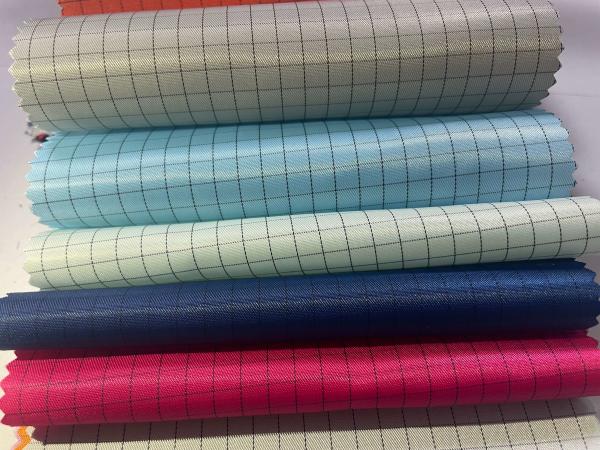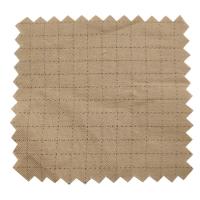Product Description:
ESD clothing made with FairtechTextiles fabrics is the best
solution for protecting electronic components against ESD. Our Anti
Static fabrics are certified to European Standards. These
antistatic fabrics are specifically designed to prevent the ESD
effect when working with electronics, high-explosive vapors, or in
super-clean lab environments.
Antistatic fabric, also known as conductive fabric or ESD
(Electrostatic Discharge) fabric, is a type of textile that is
designed to dissipate or neutralize static electricity. It is
commonly used in industries where static electricity can cause
damage to sensitive electronic components or create safety hazards.
Here's some information about antistatic fabric:
- Anti-static cloth styles: 5mm strip, 5mm grid and 2.5mm grid. It is
mainly used in the production of dust-proof clothing, anti-static
clothing, anti-static mask, anti-static gloves, anti-static shoe
and shoes cover. The fabric is 1.5m wide, surface resistance 106Ω-109Ω, available for class 10-100 cleanroom. There are four types,
- anti static polyester fabric: 98% polyester and 2% conductive yarn.
- anti static TC fabric: 63% polyester+35% cotton + 2% conductive
yarn.
- Anti static Diamond fabric.
- Anti static T Shirt fabric.
- Different type of fabric adapts to the requirements of different
anti static or cleanroom environment. It is widely used in
Microelectronics, optical electronics, precision instruments, and
aerospace which are more sensitive to static electricity and have
higher requirements in cleanroom.
Why we need the Anti static fabric?
- Uncontrolled release from static build-up is a potential hazard in
many industries, especially where combustible fuels, gases and
dusts are present. It is also equally hazardous to the safe
assembly of sensitive components in clean rooms and the operation
and maintenance of electronic equipment and controls. One of the
most serious risks is from the human body, which is capable of
generating up to 40,000 volts of static electricity. ESD occurs
when two materials come into contact and then separate, resulting
in a spark discharge when a metallic (conductive) object is
touched. This discharge can potentially damage electronic circuits,
precision machinery, and even cause gas explosions. To prevent ESD
and discharge static electricity in the air, antistatic fibers are
woven into the fabric.
- Purpose: The primary purpose of antistatic fabric is to prevent the
buildup and discharge of static electricity. Static electricity can
accumulate on the surface of materials or clothing due to friction,
and when discharged, it can potentially damage electronic devices
or ignite flammable substances. Antistatic fabric helps to minimize
these risks by providing a controlled path for the dissipation of
static charges.
- Construction: Antistatic fabrics are typically made by
incorporating conductive fibers into the fabric structure. These
conductive fibers are often carbon-based or metallic, such as
carbonized polyester or stainless steel fibers. The conductive
fibers are woven or blended with other fibers to create a
conductive network throughout the fabric.
- Conductivity: Antistatic fabrics possess a level of electrical
conductivity that allows them to quickly dissipate static charges.
The conductivity is achieved through the presence of the conductive
fibers within the fabric. This conductivity helps to minimize the
accumulation of static charges and prevent the sudden discharge
that can damage sensitive electronic components.
- Applications: Antistatic fabrics find applications in various
industries where static electricity control is crucial. Industries
that use antistatic fabrics include aerospace, automotive,
electronics, healthcare and pharmaceuticals, and microelectronics.
Features:
Conductive silk, also known as ESD Fabric is made of special
polyester filament and high quality conductive yarns, and is
designed for Class 1000 cleanroom or higher. This fabric offers
good resistance against static, chemicals and abrasion, and is
widely applicable in electronics, medicals, biology, optics,
spaceflight industries etc. It meets ESD standards, with system
resistance ranging from 10e6-10e8Ω. The unique process of ESD
Fabric spinning enables to separate or interfuse conductive fiber
fabric. This fabric is further made of metal oxide or carbon black
composite spinning, which demonstrates excellent performance in
terms of washability and to prevent the accumulation of static
electricity of clothes.
In the given temperature 20± 5 ℃ and humidity 30~40%, ESD fabric
density surface is ≤ 7.0μc/m2 after washing in 100 cycles, while
etymology of electricity of each garment is <0.6μ c/pc. In terms
of washability, A Grade ESD fabrics can be washed ≥33.0 h, while B
Grade ESD fabrics can be washed for ≥16.5 h. The scope of the
fabric utility includes various functional garments, such as
coverall, suit, jacket, caps, boots and etc.
Technical Parameters:
| Property | Value |
|---|
| Sample | Available |
| Tear Strength | 20-30N |
| Yarn Count | 100d*100d, 100d*100d |
| Flexibility | Good |
| Weight | 200-400g/m2 |
| Style | Other, TWILL, Antistatic |
| Use | Jacket, Shirt, Bag, Blanket, Cap, Curtain, Dress, Garment,
Industry, Shoes, Suit |
| Width | 58/60 |
| Color | White, Blue, Pink, Yellow, Green And Etc |
| Permeability to Water | 55.00 To 60.00g/hr |
| Material | ESD Polyester Fabric, Conductive Fabric, ESD Grid Fabric |



Applications:
Applications: Antistatic fabrics find applications in various
industries where static electricity control is crucial. Some common
applications include:
- Electronics and semiconductor manufacturing: Antistatic fabrics are
used to make garments, gloves, and cleanroom clothing for personnel
to prevent electrostatic discharge that can damage sensitive
electronic components.
- Automotive industry: Antistatic fabrics are utilized in the
production of seating materials and protective clothing to prevent
static buildup and potential hazards during vehicle assembly.
- Pharmaceutical and healthcare sectors: Antistatic fabrics are used
in cleanrooms and sterile environments to minimize static
electricity and protect sensitive equipment or products.
- Explosives and flammable substance handling: Antistatic fabrics are
employed in clothing and equipment used by workers handling
explosive materials or flammable substances to prevent static
discharge and potential ignition.
- Maintenance and Durability: Antistatic fabrics typically maintain
their conductivity and antistatic properties throughout their
useful life. However, it's important to follow manufacturer
guidelines for proper care and maintenance to ensure continued
performance. Antistatic fabrics may have specific requirements for
washing, drying, and handling to prevent any damage to their
conductive properties.
Customization:
Anti Static ESD FabricsBrand Name: Fairtech
Model Number: FR2101
Place of Origin: China
Certification: CE,ISO
Minimum Order Quantity: 100 Meter
Price: USD1.1/Meter
Packaging Details: 100-130meter/roll
Delivery Time: 3-5days
Payment Terms: L/C, D/A, D/P, T/T, Western Union, MoneyGram
Supply Ability: 10000000meter per Week
Applicable to the Crowd: Women, Men, GIRLS, BOYS
Static Decay: 0.1s
Surface Resistance: 10^6-10^9Ω
Material: Polyester / Cotton, 98% Polyester+2% Conductive Filament
Type: 5mm Grid/strip Fabric Or 4mm Grid/strip Fabric
Fairtech Anti Static ESD Fabrics (FR2101) offers complete
protection to static hazards. This fabric is designed to provide
superior static protection with CE, ISO certification. It comes
with a minimum order quantity of 100 meters and is priced at
USD1.1/Meter. The fabric is packed in 100-130meter rolls with
delivery time of 3-5days. It is available in payment terms like
L/C, D/A, D/P, T/T, Western Union, MoneyGram and the supply ability
is 10000000meter per week. The fabric is suitable for both men and
women. It features a Static Decay of 0.1s and a Surface Resistance
of 10^6-10^9Ω. It is made from Polyester / Cotton, 98% Polyester+2%
Conductive Filament and is available in 5mm Grid/strip Fabric Or
4mm Grid/strip Fabric. Get your hands on this perfect ESD Fabric
solution now!
FAQ:
Q1. What is the safe range for ESD?
A1: Static dissipative (ESD-safe) - A static dissipative material
has a surface resistivity of at least 1 x 10E5 Ω/square, but less
than 1 x 10E12 Ω/square. In terms of volume resistivity, a static
dissipative material falls in the range of 1 x 10E4 Ωcm and 1 x
10E11 Ωcm.
Q2. Which three tools are used to avoid ESD?
A2: Three primary pieces of equipment are necessary to prevent
electrostatic discharge during manufacturing:
Electrostatic wrist and heel straps for tool operators.
Electrostatic-safe tools.
Anti-static floor mats.
Q3. What is the solution to ESD?
A3: ESD SOLUTIONS
1)Optimal protection for your electronic components. controlled
dissipation of electrostatic charges.
2)Comprehensive range of ESD products. for all applications
(minimum to full protection)
3)Safe and neat storage. of your electronic components.
4)Cost reduction. no damage and latent faults on PCBs.
5)Expert planning.
Q4. What are anti static fabrics?
A4: fabric range prevents electrostatic discharges and protects
from fire thanks to the intimate mixing of its fibers. All of them
comply with standards EN 1149 Protective clothing with
electrostatic properties + EN ISO 11612 Protective clothing against
heat and flame.
Q5. Is 100 cotton anti static?
A5: In the past, the majority of protective clothing used in the
field of ESD was 100% cotton. As with all natural fibres, this
offers the advantage of being subject to only minimal antistatic
build-up without the use of additional equipment.













